A straddle carrier is a large specialized piece of machinery designed for handling various types of cargo. It is widely used in industrial, construction, and container terminal material handling applications, particularly in logistics hubs such as container terminals and yards, where it is used for the efficient handling and stacking of containers.
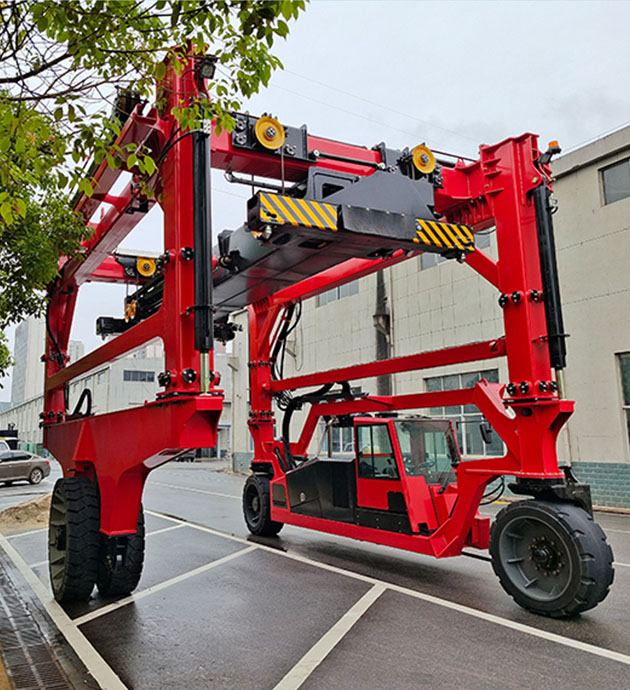
The name itself clearly illustrates its key feature: “straddle” refers to its unique gantry-style chassis structure, enabling it to span across containers like a giant striding over them. The chassis is equipped with a flexible container lifting device that can be precisely controlled via advanced hydraulic or electrical systems to perform a series of operations including grabbing, lifting, transporting, and placing containers. Thanks to this innovative design, straddle carriers have established a significant position in the logistics and handling industry.
In today’s globalized trade landscape, the volume of goods transportation continues to rise, presenting unprecedented efficiency challenges for ports and the logistics industry. As one of the core pieces of equipment for material handling, straddle carriers play an irreplaceable role.
In ports, they are responsible for quickly transporting containers from the dock front to the yard and for stacking and organizing containers within the yard, making them a critical component in ensuring the rapid turnover of port cargo.
In logistics parks, straddle carriers efficiently connect different modes of transportation, enabling seamless transfer of containers between trains, ships, trucks, and other transport vehicles, significantly enhancing overall logistics efficiency. It can be said that the performance and operational efficiency of straddle carrier cranes directly impact the smoothness and cost-effectiveness of the entire logistics supply chain, making them a crucial safeguard for the efficient operation of modern logistics systems.
In the 1960s, with the rapid growth of global trade, container transportation gradually became the mainstream method of freight transport. Traditional cargo loading, unloading, and handling methods could no longer meet the growing demand for container transportation. In this context, the straddle carrier was born. Although the exact inventor cannot be traced back to a specific individual or organization, many mechanical manufacturing companies and engineers at the time, driven by the urgent need for efficient container handling equipment, actively engaged in research and development.
Early straddle carriers had relatively simple designs and limited functionality, primarily used for basic horizontal transportation of containers from ships to yards. However, their introduction was a timely innovation, injecting new vitality into the container logistics industry and ushering in a new era of efficient container handling.
Since its inception, the cross-car has undergone multiple major technological transformations and upgrades. In terms of load capacity, with the trend toward larger containers and increasing container loads, the lifting capacity of cross-cars has continued to rise. From the initial 30–35 tons, it has gradually developed to the commonly seen 40 tons today, with some ultra-large cross-cars capable of lifting up to 50 tons. Stacking heights have also increased, with early models typically stacking two layers, while today, straddle carriers capable of stacking three layers account for approximately 70% of the market, and models capable of stacking four layers are becoming increasingly common. Lifting heights have also been significantly improved to accommodate the growing proportion of ultra-high containers in container transportation.
In terms of reliability, early straddle carriers had relatively high failure rates due to insufficiently mature technology, which to some extent limited their widespread adoption. However, with the continuous advancement of technology, an increasing number of advanced technologies have been applied to cross-carriers. For example, advanced hydraulic systems have gradually replaced traditional mechanical transmissions, effectively addressing oil leakage issues and significantly improving system reliability and stability.
In terms of structural forms, cross-carriers have also become increasingly diverse. In terms of main engine configuration, in addition to the traditional single-engine configuration (where the engine is mounted on the top of the cross-carrier, making control and maintenance relatively convenient but resulting in a higher center of gravity), dual-engine cross-carriers have emerged. Dual-engine straddle carriers position two engines on either side of the mast legs, lowering the overall center of gravity and significantly improving safety and stability. Although this design poses certain challenges for maintenance and control, it has secured a niche in the market due to its advantages.
Transmission methods are also undergoing innovation. In addition to traditional mechanical and hydraulic-mechanical transmissions, hydraulic and electrical transmission methods are developing rapidly, further enhancing the performance and efficiency of straddle carriers.
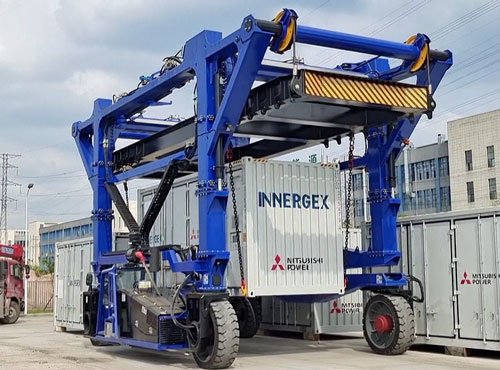
The core structure of a straddle carrier is its robust gantry frame. This unique structural design enables the straddle carrier to stabilize itself above the container, providing a solid foundation for subsequent handling operations. The frame is typically constructed from high-strength steel, offering excellent load-bearing capacity and resistance to deformation to ensure safety and reliability when handling heavy containers. On the top of the frame, there is a specially designed container lifting device. The lifting device generally consists of one or two pairs of adjustable lifting arms and precise clamps, which can be flexibly adjusted according to the size of the container. Through precise control of the hydraulic or electrical system, it securely grips the four corner fittings on the top of the container.
In terms of the driving system, the straddle carrier is equipped with high-performance tires, an efficient suspension system, and advanced steering mechanisms. The tires are typically wide-base tires, increasing the contact area with the ground, reducing tire pressure, and adapting to various ground conditions. The suspension system is carefully calibrated to effectively absorb vibrations during operation, ensuring smooth crane movement. The steering system supports multiple steering modes, such as front-wheel steering, all-wheel steering, or even crab steering (sideways movement), enabling the straddle carrier to maneuver flexibly in narrow spaces.
The lifting operations of the straddle carrier primarily rely on advanced hydraulic or electric systems. Taking the hydraulic system as an example, when the operator issues a lifting command via the control panel, the hydraulic pump begins to operate, pressurizing and delivering hydraulic fluid to the hydraulic cylinder. The piston inside the hydraulic cylinder moves upward under high-pressure fluid, synchronously lifting the attached lifting device, thereby achieving smooth container lifting. During the lowering process, the hydraulic system controls the flow and pressure of the hydraulic oil to ensure the piston descends slowly, ensuring the container is safely and accurately placed at the designated position.
The electric lifting system utilizes the rotational motion of the motor to transmit power to the lifting device via a transmission mechanism, enabling the lifting and lowering of containers. Electric systems offer advantages such as fast response speed, high control precision, and energy efficiency. With the continuous development of power technology, their application in straddle carriers is becoming increasingly widespread. Whether hydraulic or electric lifting systems, they are equipped with multiple safety protection devices, such as overload protection and limit protection, to prevent accidents during lifting operations and ensure the safety of personnel and equipment.
Compared to traditional large cranes, cross-carriers have significant advantages in terms of maneuverability. Traditional cranes are large in size, complex in structure, and difficult to move, often requiring the laying of dedicated tracks or occupying a large space for operations. Conversely, straddle carriers, with their flexible steering systems and relatively compact body dimensions, can maneuver freely in confined spaces such as narrow container yards or port terminals.
For example, straddle carriers with all-wheel steering or crab steering can perform on-the-spot turns or lateral movements in narrow passages, easily adapting to complex operational environments. This exceptional maneuverability enables cross-carriers to quickly respond to operational demands, reduce waiting times, and enhance operational efficiency. Additionally, cross-carriers have relatively high travel speeds, allowing them to swiftly transport containers from one location to another during horizontal handling, further improving the overall efficiency of logistics operations.
The standard straddle carrier is the most common type found in ports and container yards. Its design balances versatility and efficiency, enabling it to handle and stack containers of various sizes. Typically, the lifting capacity of a standard straddle carrier ranges from 30 to 50 tons, with stacking heights reaching up to three or even four layers, sufficient to meet the daily operational needs of most ports and logistics parks.
In ports, it plays a crucial role in collecting containers from shore-based container cranes and transporting them to designated locations in the yard for stacking. Additionally, when containers need to be loaded onto ships or trucks, the standard straddle carrier can quickly retrieve containers from the yard and transport them to the corresponding loading/unloading locations. Due to its high efficiency and reliability, the standard straddle carrier has become the backbone of container logistics operations in ports.
Mini straddle carriers are designed to meet the needs of small-scale logistics operations. Compared to standard straddle carriers, they are smaller in size and lighter in weight but still retain the core functions of mobile straddle carriers. Mini straddle carriers are typically suitable for small terminals, inland river ports, and small logistics warehouses.
In these locations, cargo throughput is relatively low, and operational space is limited, making it difficult for standard straddle carriers to fully utilize their advantages or even operate effectively due to space constraints. Mini straddle carriers, however, leverage their compact and agile design to operate freely in narrow spaces. Their lifting capacity generally ranges from 5 to 20 tons, which, though relatively small, is sufficient to handle the transportation needs of small containers or other cargo. Additionally, the purchase and operational costs of mini straddle carriers are relatively low, making them a highly cost-effective material handling solution for small businesses with limited budgets.
Manufacturers have developed various specialized straddle carriers to meet the needs of specific industries and operations. For example, in the steel industry, where heavy steel coils need to be transported, specially designed steel coil straddle carriers are equipped with specialized lifting devices and reinforced frames to safely and stably handle oversized and overweight steel coils.
In the chemical industry, to transport corrosive chemical containers, the body and critical components of the straddle carrier are made of corrosion-resistant materials, and the electrical system is specially protected to ensure operational safety in harsh environments.
There are also straddle carriers specifically designed for handling railway containers in railway yards, whose design fully considers the characteristics of railway tracks and operational requirements, enabling efficient loading, unloading, and transshipment of railway containers. These specialized straddle carriers, through customized design and special configurations, meet the personalized needs of different industries and expand the application scope of straddle carriers.
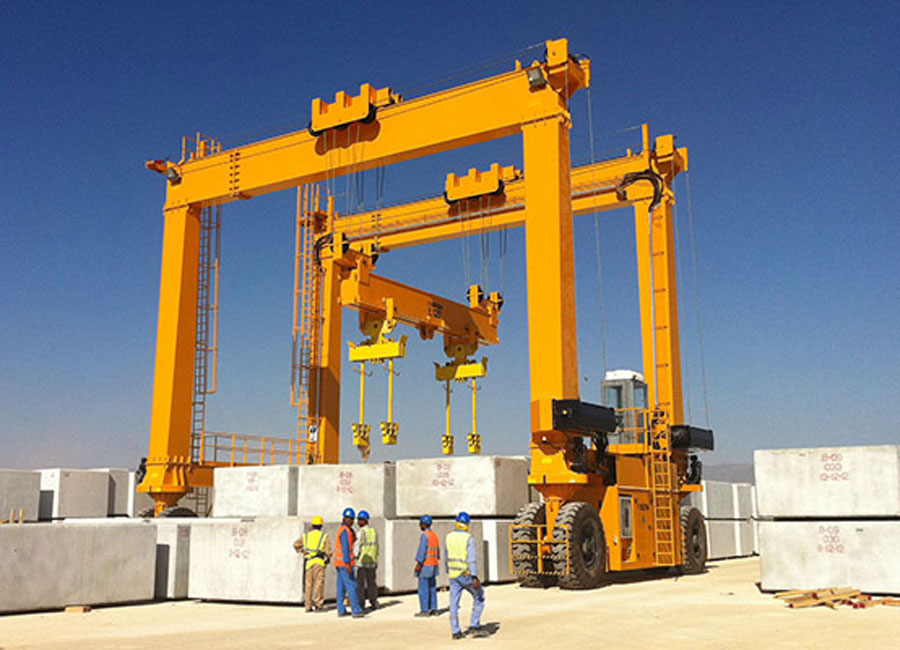
In port operations, straddle carriers play a crucial role. At the terminal front, straddle carriers work in close coordination with shore-based container cranes. After a vessel berths, the shore-based container cranes unload the containers from the ship and place them at the terminal front. At this point, the cross-car quickly moves to the container’s location, precisely lifts it using its lifting equipment, and transports it to the yard.
Within the yard, the cross-car follows the yard layout and instructions from the management system to stack the containers at designated locations accurately. During container loading operations, the process is reversed: the straddle lift crane retrieves containers from the yard, transports them to the terminal front, and waits for the shore-based container crane to lift them onto the ship. Additionally, mobile straddle carriers can be used for container transshipment between different areas within the port, such as between container yards and freight terminals, ensuring smooth port logistics operations.
In manufacturing and logistics centers, straddle carriers also play a crucial role. Within manufacturing plants, they are used to transport raw materials, semi-finished products, and finished goods. For example, automotive manufacturers use straddle carrier cranes to move large crane components from warehouses to production lines or to transport assembled cranes to logistics distribution areas.
In logistics centers, straddle carriers are used for loading, unloading, stacking, and moving goods, improving warehouse space utilization and cargo turnover efficiency. They can quickly move goods of different batches and specifications to designated storage or sorting areas, providing strong support for efficient logistics operations.
In the forestry sector, straddle carriers can be used to transport timber. In forestry production, large quantities of logs need to be transported from logging sites to processing plants or storage areas. mobile straddle carriers, with their strong load-carrying capacity and good maneuverability, can navigate rugged forest roads to transport logs to transport cranes or designated storage locations.
In the construction industry, straddle carriers can be used to transport construction materials such as precast concrete components and steel beams. These materials are often large in size and heavy in weight, making them difficult for conventional handling equipment to manage. Straddle carriers, however, can safely and efficiently complete such tasks. In heavy industrial sectors such as mining, straddle lift cranes can be used to transport large machinery, minerals, and other materials, facilitating production operations.
Straddle carriers significantly improve turnover efficiency in logistics operations. Their “one-stop” handling mode allows them to directly pick up containers from transport cranes and move them to designated locations, eliminating the need for multiple transfers and loading/unloading in traditional handling methods, thereby greatly reducing cargo handling time.
For example, in port operations, straddle carriers can quickly transport containers from ships to yards or from yards to trucks, reducing container dwell time at the terminal and improving overall terminal operational efficiency. Additionally, straddle lift cranes operate at relatively high speeds, with both travel speed and container lifting speed optimized for design, enabling the completion of large-scale handling tasks in a short time.
Furthermore, the flexibility of straddle carriers allows them to quickly switch between different operational areas, adapting to diverse operational requirements and further improving logistics turnover efficiency.
From an operational cost perspective, straddle carriers offer significant advantages. Due to their efficient operational mode, they reduce reliance on large numbers of personnel and auxiliary equipment, thereby lowering labor costs and equipment rental costs. For example, compared to traditional methods using multiple forklifts for container handling, mobile straddle carriers can complete the same workload with fewer devices and personnel.
In terms of energy consumption, modern straddle cranes adopt advanced energy-saving technologies, such as high-efficiency engines and energy recovery systems, effectively reducing fuel or electricity consumption. In the long term, this can save enterprises a significant amount of energy costs.
Additionally, straddle carriers have relatively simple maintenance and servicing requirements. Many models adopt modular designs, facilitating quick replacement and repair of faulty components, reducing downtime, lowering equipment maintenance costs, and improving equipment usage efficiency and economic benefits.
Mobile straddle carriers are equipped with a series of advanced safety mechanisms. In terms of stability control, optimized chassis structure design and advanced balance control systems ensure that mobile straddle carriers maintain high stability during full-load operation and reduce the risk of accidents such as overturning. For example, some straddle cranes use automatic leveling systems that automatically adjust the crane’s balance based on load conditions and driving status to ensure operational safety.
In terms of operator visibility, the cab design of the straddle carrier crane prioritizes visibility, providing operators with a wide and clear field of view to comprehensively observe the operational environment and promptly identify potential safety hazards. Additionally, the mobile straddle carrier is fitted with various safety protection devices, such as collision sensors, emergency braking systems, and overload protection devices. When the crane detects abnormal conditions, such as being too close to an obstacle or exceeding the rated load capacity, it immediately issues an alarm and takes corresponding safety measures, effectively ensuring the safety of personnel and equipment.
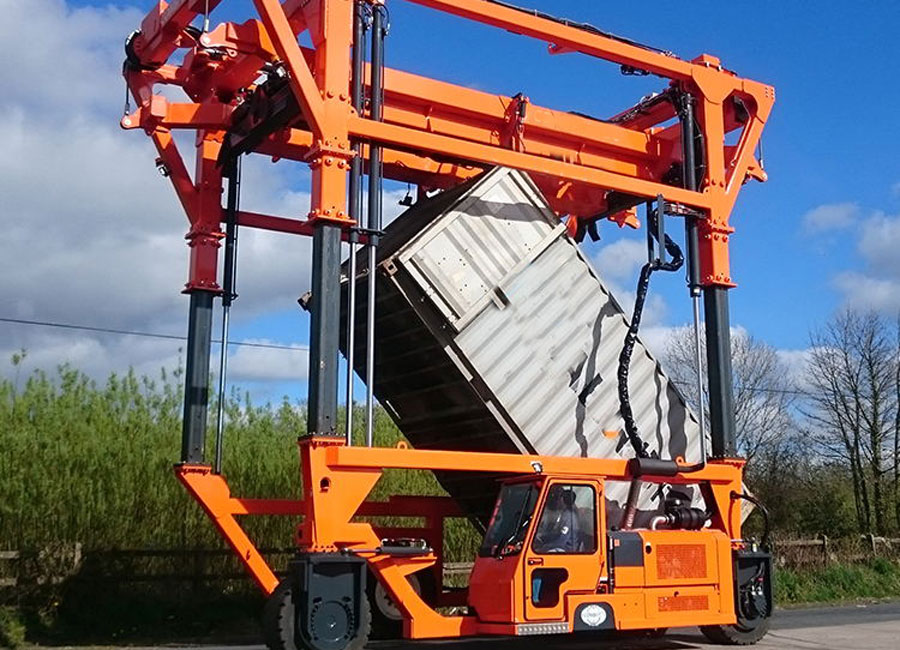
The specifications of a straddle crane are one of the key factors influencing its price. Among these, lifting capacity plays a crucial role. Generally, the larger the lifting capacity of a straddle carrier, the higher the design and manufacturing complexity, and the stricter the requirements for material strength and quality, resulting in a higher price. For example, a straddle lift crane with a lifting capacity of 30 tons may cost several hundred thousand yuan, while one with a lifting capacity of 50 tons may exceed one million yuan. In addition to lifting capacity, specifications such as lifting height and stacking layers also influence price.
A higher lifting height and more stacking layers mean the straddle needs a more powerful drive system and a more robust structure, which inevitably increases manufacturing costs and leads to higher prices.
Additionally, performance parameters such as the crane’s travel speed and turning radius also influence the price to some extent. Straddle carrier cranes with higher travel speeds and smaller turning radii often employ more advanced drive and steering technologies, resulting in higher prices.
Straddle carriers from different brands vary significantly in price. Well-known brands typically have higher market recognition and reputation, with their products offering greater assurance in terms of quality, performance, reliability, and after-sales service. These brands invest substantial resources in research and development and production, adopting advanced technologies and processes, resulting in relatively higher product prices. For example, straddle carrier cranes from some internationally renowned brands may be 30%–50% more expensive than those from niche brands.
Different models under the same brand may also vary in price due to differences in design philosophy, functional configurations, and market positioning. High-end models typically feature more advanced intelligent control systems, more efficient power systems, and more luxurious interiors, resulting in higher prices compared to base models. When making a selection, consumers should comprehensively consider factors such as the brand’s reputation, product performance, and their own budget.
Customization requirements significantly impact the price of straddle cranes. If customers have special functional requirements, such as customized lifting equipment design, explosion-proof performance, or configurations for extreme environments, manufacturers must incur additional R&D and production costs. Customized lifting equipment design may require specialized mold manufacturing and testing, while explosion-proof performance necessitates special explosion-proof treatment of the crane’s electrical and power systems, all of which increase production costs and drive up prices.
Additionally, customized straddle carriers are typically produced in smaller quantities and cannot achieve cost reductions through mass production like standard models, which is another reason for their higher prices. Generally, the price of customized straddle cranes may be 20% to 100% higher than that of standard models with the same specifications, depending on the complexity and requirements of the customization.
RTG, or Rubber-Tyred Gantry Crane, is a large lifting device commonly used in container terminals and yards. It moves on the ground using rubber tires and features a tall gantry-style bridge structure. The bridge is equipped with a hoisting trolley that can move horizontally along the bridge tracks, used for lifting and transporting containers. RTGs are primarily used for stacking and handling containers in yards, capable of moving containers between different stacks and loading/unloading containers onto trucks. Unlike straddle carriers, RTGs have a relatively fixed operational range, typically operating within the area defined by their tracks.
In terms of mobility, straddle carriers have a clear advantage. Straddle carriers can freely maneuver across the entire port and yard area, using a flexible steering system to quickly adjust their position in narrow passages and complex operational environments. RTGs, however, are restricted to specific tracks, limiting their operational range and reducing flexibility. In terms of stacking capacity, RTGs typically have higher stacking heights, with advanced models capable of stacking 5–6 layers of containers, while straddle lift cranes generally stack 3–4 layers.
In terms of operational mode, straddle carriers excel at “end-to-end” horizontal transportation, capable of directly lifting containers from ships, trucks, or other transport vehicles and moving them to stacking locations without requiring intermediate equipment. RTGs, on the other hand, typically require coordination with other equipment such as straddle carrier cranes and forklifts. For example, a straddle carrier may transport containers from the terminal front to the RTG operating area, after which the RTG performs the stacking operation. Additionally, straddle lift cranes can achieve “multi-functional use,” capable of both horizontal transportation and low-level stacking; RTGs, however, are specialized for vertical stacking and horizontal movement within specific areas, with relatively limited functionality.
From the perspective of initial purchase costs, RTGs, due to their complex structure, higher lifting heights, and greater stacking layer counts, typically cost 30%–50% more than straddle carriers of the same specifications. However, in large-scale yard operations, RTGs have lower energy consumption and labor costs per unit—they have a higher degree of automation, allowing for reduced operator numbers through remote control or intelligent systems, and their higher stacking density maximizes yard space utilization. Straddle carriers are more suitable for medium to small-sized yards or scenarios requiring frequent horizontal transportation, as their flexibility and mobility reduce equipment idle time, resulting in higher overall efficiency.
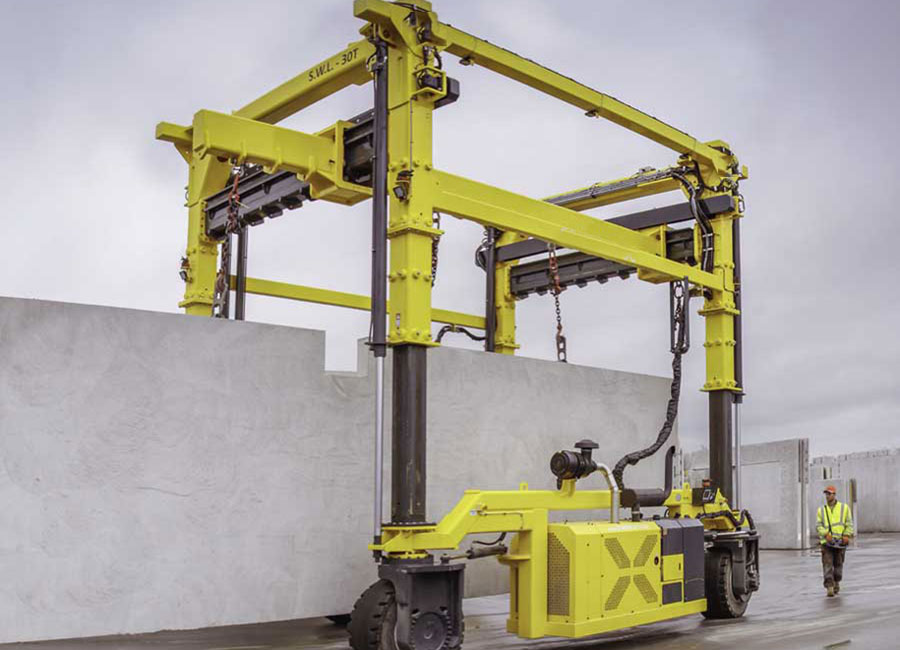
The core operational process of a straddle carrier can be summarized as “grab — lift — move — place.” When the vehicle positions itself above the container, the lifting device aligns with the container’s top corner fittings via hydraulic or electric mechanisms, and the clamps automatically lock into place. The lifting system then activates, with hydraulic cylinders or motors driving the lifting device to smoothly lift the container to the specified height. After the vehicle moves to the target position via the driving system (diesel engine or electric motor-driven tires), the lifting device slowly lowers the container, precisely placing it on the ground or stack, completing a single handling cycle.
Throughout the process, the operator monitors the lifting device’s position, lifting height, and travel speed in real-time via the cab dashboard and monitoring screens, ensuring precise and safe operations.
The control systems of modern straddle carriers are increasingly intelligent, primarily divided into manual control and automated control categories. In manual mode, the operator directly controls the lifting device’s movement, vehicle steering, and travel speed via joysticks and buttons, suitable for complex environments or special operational requirements. Automated mode leverages technologies such as laser navigation, GPS positioning, and sensors to achieve path planning, automatic obstacle avoidance, and precise parking. For example, in automated yards, straddle carriers can automatically complete container handling tasks according to instructions from the Terminal Operating System (TOS) without human intervention.
Some high-end models also support remote control, enabling operators to manage multiple straddle carriers in real-time from a control center via video monitoring and data transmission, significantly enhancing operational efficiency and safety.
In port scenarios, the loading and unloading process of straddle carriers is closely linked to transportation tools such as ships and trucks. When a container ship docks, the shore crane unloads the containers to the front of the terminal, and the straddle lift crane quickly approaches, grabs the containers, and transports them to the rear yard. If containers need to be loaded onto a ship, the process is reversed: the straddle carrier crane retrieves containers from the yard, transports them to the terminal front, and the shore crane lifts them into the ship’s hold.
In the road transport interface, the straddle carrier can directly move containers from the yard onto the trailer of a container truck or unload containers from the truck and stack them in a designated area, achieving seamless “door-to-door” loading and unloading and reducing cargo transshipment losses.
Companies should select straddle carriers of appropriate specifications based on their cargo type, transportation scale, and operational frequency. For example, if primarily handling 20-foot or 40-foot standard containers, ensure the straddle carrier’s lifting equipment is compatible with the corresponding dimensions, and select a model with matching lifting capacity based on the maximum container weight (e.g., a common 40-ton straddle carrier crane can accommodate most standard containers).
For large ports with high-frequency operations, multiple straddle carriers can be deployed to work in coordination, paired with an automated scheduling system to enhance efficiency; smaller logistics companies may prioritize mini straddle carriers or used equipment to reduce initial investment costs.
Ground bearing capacity and operational space are critical considerations. Straddle carriers have significant self-weight (typically 30–80 tons), and when combined with container loads, they impose high demands on ground flatness and bearing strength. When operating on soft soil foundations or uneven terrain, the ground must be pre-hardened, or models equipped with wide-base tires and high-traction suspension systems should be selected to prevent vehicle sinking or ground damage.
If the operational area has limited space (e.g., inland river ports or older yards), models with a small turning radius and full-wheel steering capability should be selected to ensure flexible operation in confined spaces.
Operator training is the foundation for ensuring the safe and efficient operation of straddle carriers. Companies must establish comprehensive training programs to ensure operators are familiar with equipment structure, operating procedures, and emergency response protocols, such as how to properly use lifting device locking mechanisms and how to handle sudden malfunctions. Additionally, strict safety management systems must be established, including regular equipment inspections, work area isolation, and speed and load limits.
For example, during stacking operations, it is essential to ensure that the number of stacking layers does not exceed the equipment’s design limits and to install prominent warning signs to prevent collapse risks. Regularly organizing safety drills to enhance operators’ ability to handle emergencies is also a crucial measure to reduce operational risks.
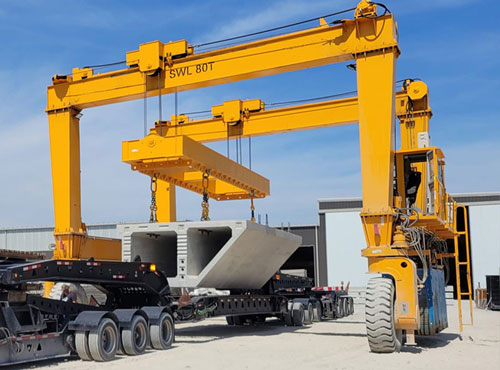
Automation is becoming the core direction of straddle carrier technology development. In the future, straddle carriers equipped with lidar, visual sensors, and AI algorithms will achieve fully autonomous operations throughout the entire process—from receiving logistics system instructions and planning optimal paths to automatically completing container handling, transportation, and stacking—without any human intervention.
For example, the Port of Rotterdam in the Netherlands has piloted the deployment of fully automated straddle carriers, which are interconnected with the terminal management system via 5G networks in real time, resulting in a 40% increase in operational efficiency. The application of robotics technology will also drive the development of straddle carrier cranes toward a “driverless fleet” model, where multiple devices collaborate through algorithmic coordination to achieve cluster operations, further optimizing yard resource allocation.
As global demand for low-carbon logistics grows increasingly urgent, the power systems of straddle carriers are accelerating their transition toward electrification and intelligence. Pure electric straddle carriers are powered by high-capacity lithium-ion batteries, operating with zero emissions and low noise, making them suitable for use in ports and urban logistics centers with strict environmental requirements.
Some models are also equipped with energy recovery systems that convert braking energy into electricity for storage, extending the vehicle’s range. Hybrid straddle carriers combine diesel engines with electric motors to maintain range while reducing fuel consumption and carbon emissions. Hydrogen fuel cell technology is also being piloted on straddle carriers, generating power through hydrogen combustion with emissions limited to water, truly achieving green logistics.
In the future, straddle carriers will be deeply integrated into smart logistics ecosystems, seamlessly connecting with port operating systems (TOS) and transportation management systems (TMS) through IoT technology. For example, straddle carriers can use onboard sensors to upload real-time operational data (such as location, load, and energy consumption), and logistics management systems can use this data to optimize scheduling strategies, dynamically adjust equipment assignments, and plan routes.
Additionally, the collaborative operations between straddle carrier cranes and other equipment such as drones and automated guided vehicles (AGVs) will become even more integrated — drones will handle yard inspections and inventory counts, while straddle lift cranes and AGVs will handle cargo handling, forming a highly intelligent logistics operation network that significantly enhances the overall efficiency of the supply chain.
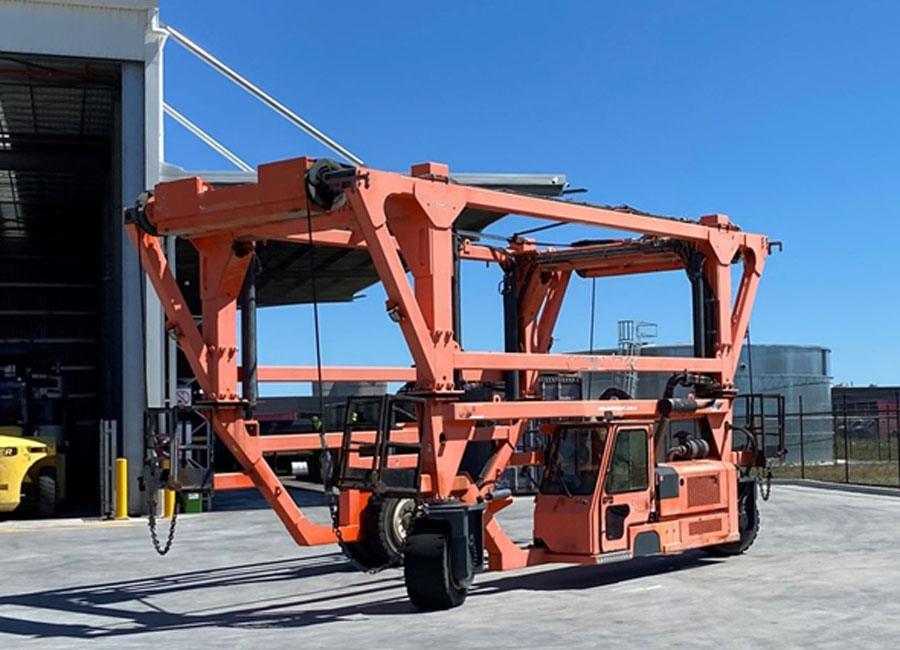
As the global logistics industry continues to grow rapidly, the demand for efficient, intelligent, and green material handling equipment will continue to rise. Whether for large port operators or small and medium-sized logistics companies, straddle carriers can deliver significant improvements in operational efficiency and cost optimization.
If you are planning logistics equipment upgrades or new project construction, please contact us — as a professional straddle carrier manufacturer, Huadelift can provide customized solutions tailored to your specific needs, covering equipment selection, technical support, and after-sales service throughout the entire process. Contact us today and let straddle carriers become your reliable partner for logistics upgrades!